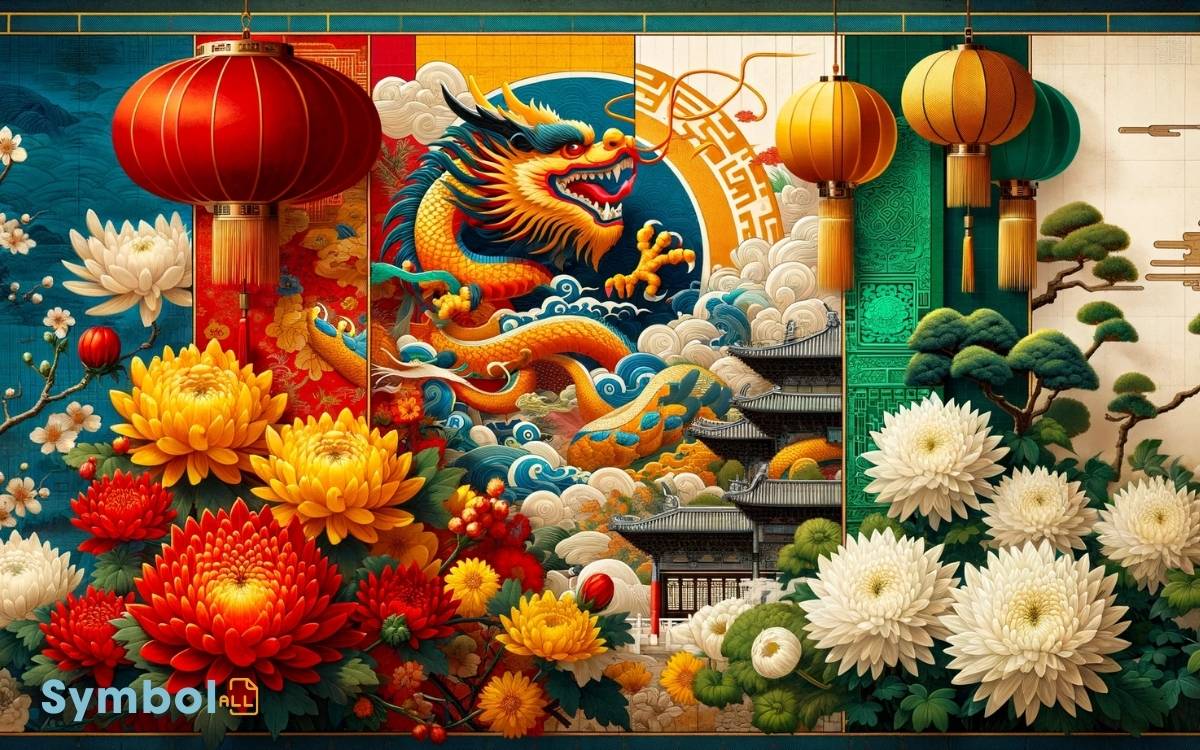Color Symbolism in Chinese Culture: Joy, Pivotal!
In Chinese culture, colors aren’t just hues; they’re rich with meanings. Red brings you prosperity and joy, pivotal in celebrations like Chinese New Year.
Imagine wearing red at your wedding, symbolizing love and attracting good fortune. Yellow promises prestige, once reserved for Emperors, symbolizing spiritual sanctity. White, though, reflects mourning and purity, worn at funerals to express loss and remembrance.
Black exudes mystery and sophistication, linked to authority and elegance. Green, mirroring nature, brings harmony and health into your life.
Each color weaves a complex tale of history, emotions, and values, inviting you to uncover deeper layers of cultural significance.

Key Takeaways
9 Color Meanings in Chinese Tradition
| Color | Symbolism in Chinese Culture | Occasions/Usage |
|---|---|---|
| Red | Good fortune, joy, prosperity, vitality, beauty, enthusiasm, love | Weddings, New Year, celebrations |
| Yellow | Nourishing, royalty, power, respect, imperial family | Imperial ceremonies, cultural events |
| Blue | Healing, trust, long-lasting, immortality | Health-related events, decor |
| Green | Health, harmony, wealth, growth, cleanliness | Everyday use, businesses |
| Black | Mystery, sophistication, the unknown, evil, sadness | Funerals, solemn occasions |
| White | Purity, mourning, humility, brightness, metal, autumn | Funerals, memorials |
| Gold | Wealth, freedom, dynamic, fullness, nobility | Festivities, ornaments |
| Purple | Nobility, romance, luxury, creativity | Cultural events, art |
| Pink | Love, happiness, femininity | Romantic occasions |
The Power of Red
In Chinese culture, the color red embodies prosperity, joy, and good fortune, deeply influencing celebrations, weddings, and traditional rituals. You’ll find it prominent during Chinese New Year and other festivals, where red decorations and clothing are ubiquitous.
This color isn’t chosen at random; it’s believed to ward off evil spirits and attract positive energy. Analyzing the use of red in weddings, you’ll notice brides often wear red dresses, symbolizing love and happiness in their new journey.
Moreover, red envelopes containing money, given during holidays and special occasions, serve as wishes for prosperity and good luck.
This tradition underscores a communal desire for success and well-being, marking red’s pivotal role in fostering a sense of unity and collective optimism among participants.
Yellow: Imperial and Sacred
You’ll find that yellow holds a dual significance in Chinese culture, rooted deeply in both historical prestige and spiritual sanctity.
It was the exclusive color of the emperor for centuries, symbolizing his supreme power and the earth’s centrality. Meanwhile, in religious contexts, yellow signifies enlightenment and is often associated with Buddhist rituals and garments, reflecting its sacred essence.
Historical Significance
Throughout Chinese history, yellow has symbolized imperial power and sacredness, deeply rooted in the nation’s cultural and religious practices.
This color’s historical significance is vast and multifaceted:
- Exclusive Use: Reserved for the emperor and his palace, yellow embodied the ultimate authority and celestial connection.
- Architectural Dominance: Imperial palaces and temples often featured yellow-glazed roof tiles, signifying their divine and regal nature.
- Garment Regulation: High-ranking officials and the imperial family were the only ones permitted to wear yellow garments, further demarcating social hierarchy.
- Literary Symbolism: Ancient texts frequently used yellow to represent nobility, honor, and a connection to the earth, reinforcing its esteemed status.
Understanding yellow’s historical context enriches your appreciation of its profound significance in Chinese culture, beyond mere aesthetic appreciation.
Religious Representations
Yellow’s significance seeps deeply into Chinese religious practices, symbolizing both imperial authority and sacred divinity. Historically, yellow became synonymous with the earth, central to the Chinese cosmological system, embodying balance and neutrality.
In Buddhism, yellow signifies renunciation and detachment, marking the monks’ robes, distancing them from worldly temptations and desires. It’s not merely a color but a pathway to enlightenment, representing humility and freedom from materialism.
In Taoism, yellow holds a profound connection to the Tao, the source of harmony and ultimate reality. It’s used in temples and rituals, emphasizing the pursuit of wisdom and harmony with the natural world.
You’ll find that yellow bridges the earthly with the celestial, inviting a deeper understanding of the universe’s mysteries and one’s place within it.
White: Mourning and Purity
In Chinese culture, white embodies both the solemnity of mourning and the virtue of purity. This color’s dual symbolism is deeply ingrained, and you’ll find its presence both comforting and respectful in various contexts.
Here’s how white plays a significant role:
- Funerals and Memorials: White is traditionally worn at funerals, symbolizing both respect for the deceased and the mourning process.
- Spiritual Purity: It’s associated with purity and cleanliness, often used in religious ceremonies to represent a clear mind and soul.
- Clothing Choices: Traditional garments for significant life events, aside from funerals, may also be white, emphasizing the person’s pure intentions.
- Home Decor: Even in home decor, white elements can signify a peaceful, pure space, inviting tranquility and calmness.
Understanding white’s dual symbolism offers insight into Chinese cultural values and attitudes towards life, death, and purity.
Black: Mystery and Sophistication
Black’s allure, often associated with mystery and sophistication, resonates deeply within Chinese culture, offering a nuanced perspective on its significance.
Unlike its somber connotations in some cultures, in Chinese tradition, black embodies strength, authority, and depth of knowledge. It’s a color that’s both grounding and powerful, often used in clothing and decor to convey a sense of solemnity and respect.
| Aspect | Significance |
|---|---|
| Clothing | Authority, Elegance |
| Calligraphy | Depth of Knowledge |
| Architecture | Stability, Mystery |
Black’s role is multifaceted it’s as much about the unseen, the unknown, as it is about the tangible strength it represents. It invites you to look beyond the surface, urging a deeper understanding of the world around you.
Green: Harmony and Health
Shifting focus to another dynamic aspect of Chinese culture, green embodies harmony and health, reflecting the natural world’s energy and balance. This color’s significance is deeply rooted, offering insights into values and beliefs that prioritize equilibrium and well-being.
To appreciate green’s role, consider these aspects:
- Natural Connection: Green symbolizes the lushness of nature, suggesting a life in harmony with the environment.
- Health Representation: It’s often associated with healing properties, promoting physical and mental well-being.
- Youthful Vigor: Green also stands for youth and new beginnings, embodying hope and rejuvenation.
- Symbol of Prosperity: Beyond health, it signifies growth, akin to spring’s renewal, pointing to prosperity and abundance.
Understanding green’s multifaceted symbolism offers a deeper appreciation of Chinese cultural values, where balance and health are paramount.
Blue: Immortality and Healing
As you explore the significance of blue in Chinese culture, you’ll find that its historical roots in symbolizing immortality are profound.
This color, often associated with the heavens and the sea, embodies a deep sense of healing and tranquility.
Today, its implications extend into modern health practices, reflecting a continuity of cultural beliefs and their adaptation over time.
Blues Historical Significance
In Chinese culture, the color blue symbolizes immortality and healing, reflecting its profound historical significance. This connection isn’t merely superficial; it’s deeply ingrained in various aspects of Chinese history and spirituality.
Consider these points:
- Blue in Ancient Texts: Historical documents and religious texts often depict the heavens and the immortals wearing blue, suggesting a divine connection and eternal life.
- Blue in Traditional Medicine: Ancient healing practices used blue-colored herbs and stones, believed to harbor healing properties and longevity.
- Blue in Art and Porcelain: Blue motifs in pottery and paintings were thought to convey messages of rejuvenation and spiritual wellness.
- Blue in Architecture: Temples and palaces adorned with blue signify a quest for eternal life and protection from evil.
Analyzing these elements reveals blue’s deep-rooted association with immortality and healing, showcasing its timeless significance in Chinese culture.
Modern Health Associations
The modern interpretation of blue in Chinese culture continues to embody its historical significance of immortality and healing, particularly in health-related practices and beliefs.
This color’s association with calmness and serenity has been leveraged in modern wellness approaches, demonstrating its enduring influence.
| Aspect | Significance |
|---|---|
| Mental Health | Calmness and Stability |
| Physical Healing | Associated with Traditional Medicine Practices |
| Spiritual Wellness | Symbolizes Inner Peace and Tranquility |
| Environmental Influence | Promotes Healing Spaces |
You’ll find that blue’s role extends beyond aesthetics, deeply ingrained in the fabric of health and wellness. Its presence in spaces intended for healing or meditation isn’t just by chance but is a reflection of its historically rooted implications for health and immortality.
Gold: Wealth and Strength
Embodying both wealth and strength, gold holds a revered position in Chinese culture, symbolizing prosperity and power that you might aspire to. Its significance is deeply ingrained, reflecting not just material wealth but also a strong, prosperous state of being.
Here’s how gold’s symbolism uniquely manifests:
- Festivals and Celebrations: Gold is prominently featured in decorations and gifts, embodying wishes for wealth and happiness.
- Fashion and Jewelry: Wearing gold signifies status and success, believed to attract positive energy.
- Architecture: Imperial palaces and temples often incorporate gold, symbolizing divine protection and eternal strength.
- Art and Craftsmanship: Gold leaf and paint are used in traditional art, highlighting importance and reverence.
Analyzing gold’s role in Chinese culture reveals a complex layering of meanings, blending aspirations of wealth with deeper notions of strength and resilience.
Silver: Elegance and Nobility
You’ll find that silver, with its gleaming surface, has long been associated with elegance and nobility within Chinese culture. Its traditional uses in decor reflect a deep appreciation for its beauty and its role in symbolizing purity and serenity.
When it comes to jewelry, silver’s symbolism extends to convey messages of grace and dignity, underpinning its enduring value and significance.
Traditional Uses in Decor
In traditional Chinese decor, silver symbolizes elegance and nobility, often used in artifacts and designs to convey a sense of refined sophistication. When you explore the traditional uses in decor, you’ll find silver’s presence is both meaningful and widespread.
Here’s how:
- Tea Sets: Silver tea sets aren’t just functional; they’re a statement of status and taste, reflecting the owner’s appreciation for the finer things.
- Vases: Intricately designed silver vases hold more than flowers; they encapsulate centuries of artistic tradition, adding a layer of cultural depth to any space.
- Wall Hangings: Silver in wall hangings or frames signifies wealth and prosperity, offering a subtle yet powerful display of affluence.
- Utensils: Beyond mere utility, silver utensils serve as a nod to the historical value placed on cleanliness and purity in Chinese culture.
Understanding these traditional uses helps you appreciate the depth and breadth of silver’s role in Chinese decor.
Symbolism in Jewelry
Silver jewelry in Chinese culture isn’t just about adornment; it carries deep meanings of elegance and nobility that have been cherished for centuries. When you explore the symbolism, you’ll find that silver’s significance goes beyond its shimmering appearance.
Historically, it symbolized wealth and high social standing, making it a preferred material for jewelry among the nobility. The luster of silver is often associated with the moon’s soft glow, embodying purity, clarity, and a calm strength.
This link to the celestial reflects a balance between the spiritual and the earthly, indicating a wearer’s noble character and refined taste.
Pink: Love and Happiness
Embodying both love and happiness, pink holds a cherished position in Chinese culture. This color’s gentle hue resonates deeply, symbolizing a blend of emotions and principles that are universally valued.
Here’s why pink is so significant:
- Universal Symbol of Love: Across cultures, pink represents affection and warmth, but in Chinese culture, it’s particularly tied to the concept of unconditional love and care.
- Youth and Joy: It’s associated with the innocence and playfulness of youth, evoking feelings of joy and nostalgia.
- Marital Bliss: Pink is often used in wedding decorations to symbolize a blissful union, promising a future filled with happiness.
- Cultural Festivities: During festivals, pink adorns streets and homes, celebrating love, life, and the coming together of communities.
Orange: Transformation and Change
Orange, a vibrant symbol of transformation and change, captivates the senses and marks significant life shifts in Chinese culture. It embodies the dynamic spirit of adaptability and progress, resonating deeply with those who are setting sail the currents of change.
You’ll find orange in the heart of celebrations and rituals that signify steering through, from the joyous uproar of a wedding to the solemnity of a seasonal festival.
This color, with its bright, fiery hue, encourages energy and enthusiasm, making it a beacon for those seeking renewal or journeying through new ventures.
It’s not just a visual feast; it’s a profound reminder that change is both inevitable and fertile ground for growth. In embracing orange, you’re aligning with a culture that sees transformation as an essential part of life’s journey.
Purple: Spiritual Awareness
In Chinese culture, purple is revered as a color of spiritual awareness, symbolizing a deep connection to the mystical domains and the pursuit of wisdom.
When you explore its significance, you’ll find that:
- Purple represents nobility and sacredness, often associated with the higher domains of spirituality.
- It’s linked to meditation and enlightenment, suggesting a pathway to understanding the universe’s mysteries.
- This color is seen in various religious and spiritual artifacts, illustrating its role in connecting the mortal world with the divine.
- Finally, wearing or using purple in daily life is thought to enhance spiritual growth and encourage introspection.
Understanding purple’s place in Chinese culture offers a unique lens through which to view the broader tapestry of meanings colors can convey, especially in the domain of spirituality.
Conclusion
In sum, colors in Chinese culture aren’t just a feast for the eyes; they’re a rich tapestry, weaving deep meanings and beliefs into the fabric of daily life.
From red’s commanding power to purple’s spiritual depth, each hue carries weight, shaping perceptions and guiding actions.
As you’ve seen, whether it’s marking a change or celebrating purity, colors serve as silent narrators, telling tales of tradition, emotion, and aspiration. So next time you pick a color, remember, you’re holding a piece of cultural wisdom.






